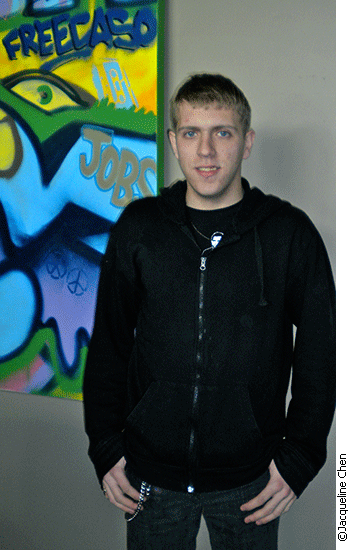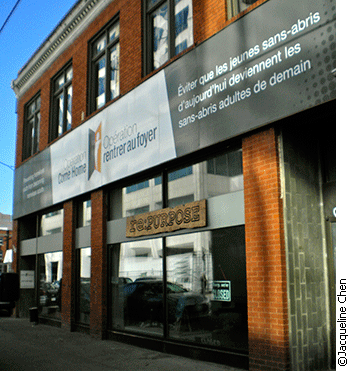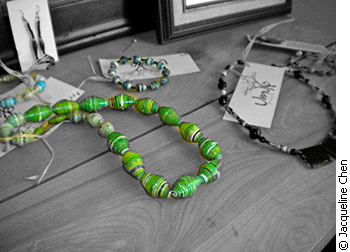Tags
Related Posts
Share This
Homeless youth, beading for a better tomorrow
In his green collared shirt and dress pants, Michael Tremblay doesn’t look like someone who will be leaving work only to spend another night at the Ottawa Mission shelter. His co-worker James, who asked that his last name not be disclosed, says he’s still in his “couch-surfing stage.” For these two, the fight against homelessness began two years ago.
Tremblay, now 22, first arrived to the capital city by hitchhiking from his home in Nova Scotia. There were simply too many demons at home, he explained. “Every day there was family drama, family issue,” he says. “I had to remove myself from that scene.” After a month with the Occupy Ottawa movement, Tremblay eventually found himself without work for two months. “I basically McGuyvered it and went on nothing,” he says, laughing. Each day was a new challenge, he explains. He had to make do with whatever he had on hand.

Now employed at Operation Come Home’s BeadWorks workshop, Michael Tremblay, 22, arrived here two years ago on his own.
For 28-year-old James, severe depression and anxiety left him without work, pushing him into financial turmoil. The street life exposed him to a world of “long-time drug and alcohol addicts,” and he was appalled. “I needed food; I needed a safe place to be because at a lot of the places downtown, and with the street services, you come across bad people and things,” he says. “I just didn’t want to be around that.”
Then James and Tremblay discovered Operation Come Home (OCH), an Ottawa-based support centre for homeless or at-risk youth. The organization offers multiple employment programs and support services for “street youth.” Among these is BeadWorks, a workshop where homeless youth design and create one-of-a-kind jewellery. The pieces are then sold at Re:Purpose, the OCH storefront at 150 Gloucester Street.
“One day, I just set foot in here and didn’t know what the hell I was doing,” Tremblay recalls his first visit to BeadWorks. “I just sat my ass down and tried to make whatever I could.”
Similarly, James frequented OCH for their many services and stumbled upon BeadWorks. Through the program, he uncovered his talent for beading and jewellery making. Now his jewellery and t-shirt designs are displayed at Re:Purpose. For each sale, the individual youth receives 75 per cent, and the remaining 25 per cent goes towards Re:Purpose and the BeadWorks program.
Helping the homeless
OCH receives much sponsorship and support from the City of Ottawa and various companies throughout the city, such as United Way Ottawa, says OCH executive director Elspeth McKay. The OCH Board of Directors comprises distinguished members of the Ottawa community, from the Ottawa Police Services to small business owners. With this assistance, OCH is able to provide other hands-on programs, McKay explains, such as FarmWorks, where youth can learn about farming and agriculture. They also offer literary courses, like Finance Matters, to provide lessons about debt, savings and budgeting.

Located at 150 Gloucester Street, Operation Come Home hosts multiple employment and educational programs for street youth.
At the OCH’s Re:Purpose store, there are products from BeadWorks and other businesses with mandates for a social cause. Items include fruit jams made by disabled youth, or handcrafted cards with a focus on environmental awareness. McKay hopes to soon display work from young artists, including a focus on using recycled material.
“This way we have what I call a triple or quadruple bottom line,” she says. “There is this eco-friendly emphasis, and the fact you’re employing at-risk or homeless youth when you buy products from them. Then there’s the fact they have an opportunity to be creative in a safe environment.”
At Re:Purpose, Tremblay and James serve as staff members, working four days per week for minimum wage. The cash they receive mainly goes towards clothing and food, Tremblay says, though he admits it also helps him pay for his cigarettes.
McKay says BeadWorks’s focus isn’t just about providing opportunities for cash. Instead, the program gives the youth some relief from the harsh world of homelessness. “I think it gets them thinking of other things rather than where they’re gong to sleep at night or how they’re going to cope with the fact they don’t have enough clothing. These are things we take for granted.”
Yet challenges persist, McKay explains. The main challenge for Re:Purpose, and for many social enterprises, is finding a business model that is profitable and continues to address social issues. That’s where new volunteer Manjit Basi comes in.
Once the owner of the Ottawa cosmetics store The Body Shop, Basi is no stranger to successful social enterprises. The Body Shop, she explains, boasted an extremely successful business structure, while remaining true to its eco-friendly mandate. With her experience, she hopes to teach the Re:Purpose youth more about the retail world, such as how to create an inviting sales environment or market a product or publicize a good story.

Jewellery on offer at Re:Purpose. Every dollar that customers spend at Re:Purpose guarantees 75 cents for homeless youth.
First, Basi needs to ensure that Re:Purpose stocks quality products that are relevant to customers. “At the end of the day, if they don’t want to buy, you’re not going to make any money, no matter how good the cause is,” she says. “A good story with a [bad] product isn’t going do anything.”
Looking to the future
It’s a great start that Re:Purpose now showcases young, local talent, including BeadWorks’s youth, Basi says. There are more sales happening, and the storefront is heading in the right direction, she adds. For long-term growth, she hopes she can teach the young people more about pricing, and encourage them to follow retail trends. “So far, the youth are so engaged,” Basi says with utmost enthusiasm. “I think they’re so smart, so talented and hungry for knowledge.”
This is especially true for James. With the experience of Beadworks under his belt, he hopes to find his way into a college to study fashion design and launch a career.
Meanwhile, Tremblay will be adding his work to his résumé and hoping to reunite with family in Montreal and find stable employment. This desire to regain the right path is one shared among all street youth, he says, despite any drug or alcohol addictions or personal problems.
“We want to move on and find our own way,” Tremblay says. “This place has helped in more ways than I can understand.”
Revamping Re:Purpose
Before the creation of the shop Re:Purpose, Operation Come Home desperately needed a space to display its BeadWorks jewellery, explains OCH executive director Elspeth McKay. With United Way and Hydro Ottawa’s Brighter Tomorrows Fund, Elspeth was able to “retrofit” OCH by identifying areas to improve energy efficiency.
Hydro Ottawa’s manager for public affairs, Claudia Lemieux says the fund would ensure that OCH was properly insulated and its windows durable for winter. This could potentially save thousands of dollars on energy costs, she explains.
“Operation Come Home then decided they were going to create this store, [Re:Purpose], and we helped with the building process,” Lemieux says. “That’s a good story for everybody in every way.”
Since its unveiling in September, Re:Purpose boasts a clean and natural look, with colour tones of light blue and white. Jewellery and other products are neatly displayed on the wooden shelves. It seems minimalist and some shelves are empty, says Tremblay, but it still marks a huge improvement from before.





